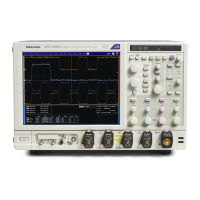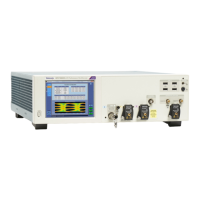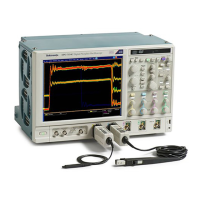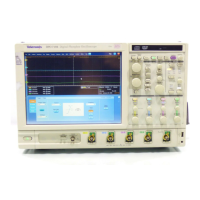Theory of Operation
Module Overvi
ews (MSO/DPO5000 Series)
The module o verviews describe the basic operation of each functional circuit
block. (See Figure 2-4 on page 2-13.)
A Microsoft Windows processor system is the primary controller of the instrument.
The instrument features a flat-panel display, a transparent touch screen, and a
front-pane
l w ith direct access to commonly used instrument functions. You can
also make complete use of the instrument with a mouse and keyboard.
Input Signal Path
An analog signal enters the instrument through a connection to an input connector
on the fro
nt panel.
Main Acquisition Board.
Each cha
nnel on the Analog board comes onto the Main board and is routed to
two of the analog-to-digital converters (A/Ds) on the Main board. Triggers from
the Analog board go to the trigger ASIC. The A/D digitizes your signal and sends
it to one or two of the four demuxes on the Main board. The demux sends the data
to on-board DDR2 acquisition memory.
The demuxes are tied together through two busses, an LVDS ring bus (IDC) and
a 3.3 V parallel b us (PA). The demux interacts with the trigger ASIC and also
performs display functions. For MSO models, the trigger ASIC also performs the
acqu
isition function for the digital probe, which connects directly to the Main
board. The acquisition data and display data are sent by the IDC and PA buses
to the SMIA FPGA, which controls various acquisition functions. The SMIA
controls acquisition devices through the SPI, IIC, PA, IDC, and GPIO busses.
The SMIA communicates through a local bus to the PLX device. The PLX
device provides a PCIe interface to the host computer module. The Main board
co
ntains many local switching power supplies to support all of the acquisition
and trigger ASICs.
Analog Acquisition Board.
The signal enters the instrument through a front-panel BNC connector, which is
connected to the Analog board. The Analog board contains the 50 Ω and 1M Ω
paths to the pre-amp ASIC (preamp). The higher bandwidth boards have two
preamps per channel, and the lower bandwidth boards have one preamp per
channel. The 1M Ω path has an attenuator network, which allows the routing of
various gain settings into the preamp.
The Analog board has a calibrated voltage reference (CVR), which is used to
calibrate the signal path. The Analog board has a microprocessor that handles
various communication and calibration algorithms. The Analog board is controlled
through the SPI bus. The preamp has outputs that go to the A/D and the trigger
ASIC on the Main board. Hardware filters limit the bandwidth of the instrument
on the output of the preamps before the signal goes off board to the A/D.
2–10 MSO70000/C, DSA70000B/C, DPO70000B/C, DPO7000, MSO5000, DPO5000 Series

